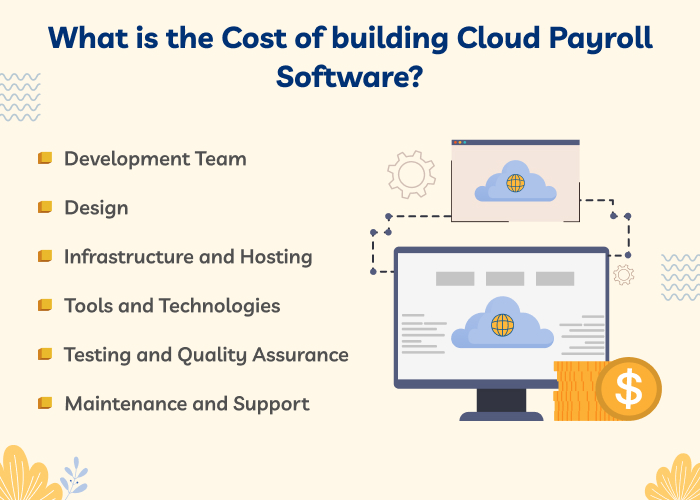What are the important features to add to cloud payroll software?
- Employee Self-Service Portal: Permit workers to view payroll data, including tax returns, pay stubs, and accrued time off. This lessens the workload for HR and gives workers more authority over their data.
- Automated Payroll Processing: Automate payroll, tax, deduction, and benefit computations. By comparison, this reduces mistakes and saves time over manual processing.
- Tax Compliance Tools: Provide tools to precisely compute and deduct taxes according to the most recent tax legislation. In order to guarantee that all government requirements are followed, the program should also create and submit tax forms.
- Integration Capabilities: To simplify data transmission and cut down on effort duplication, make sure that other HR systems, accounting software, and timekeeping systems integrate seamlessly.
- Customizable Reporting: Provide a range of pre-built reports for compliance, tax reporting, and payroll analytics. Permit users to generate personalized reports based on their own requirements as well.
- Time and Attendance Tracking: To precisely measure employee hours worked, including overtime, shift differentials, and paid time off, integrate timekeeping functions.
- Direct Deposit and Payment Options: Payrolls should be deposited directly into employees’ bank accounts, and pay cards and paper cheques should be accepted as backup payment options.
- Mobile Accessibility: Allow users to access payroll information and complete duties while on the move by offering a mobile-friendly interface or a specialized mobile app.
- Customer Support and Training: Provide thorough customer support services, including training materials, guides, and competent support representatives to help users with any problems or inquiries they might have.
What is the cost of building cloud payroll software?

Building cloud payroll software may have a wide range of costs depending on a number of variables. Let’s take a look at them:
- Development Team: Hiring developers, software engineers, UI/UX designers, and project managers is the main expense. Developers may charge approximately $55 to $100 per hour or more, based on their location and level of experience.
- Design: UI/UX design, graphics, and branding components are all included in design fees. It can cost anywhere from $4,000 to $15,000 or more to hire a professional designer or design team, depending on the complexity and scope of the design needs.
- Infrastructure and Hosting: Services for infrastructure and hosting are necessary for cloud-based applications. The price of cloud hosting might change depending on things like bandwidth use, data storage, and server resources. Different usage-based pricing models are available from providers such as Microsoft Azure, Google Cloud Platform, and Amazon Web Services (AWS).
- Tools and Technologies: Buying licenses or subscriptions for development tools, frameworks, and libraries may incur fees, depending on the development platform and technologies utilized.
- Testing and Quality Assurance: It is crucial to test the program for security flaws, performance issues, and functional issues. The necessary testing scope and the length of the testing phase will determine the costs associated with testing and quality assurance.
- Maintenance and Support: Support, upgrades, and ongoing maintenance are necessary to keep the program safe from new threats and operate smoothly. For the program to remain viable over time, budgeting for continuing maintenance expenses is essential.
Conclusion
When creating cloud payroll software, elements that guarantee accuracy, expedite workflows, and improve user experience must be carefully considered. Businesses may improve payroll processes and maintain regulatory compliance by giving priority to features like employee self-service portals, automated payroll processing, tax compliance tools, and integration capabilities.
However, depending on variables including development team costs, design specifications, infrastructure and hosting costs, tools and technologies utilized, testing and quality assurance efforts, and continuing maintenance and support requirements, the cost of developing cloud payroll software can differ greatly. The advantages of cloud payroll software, which include improved efficiency, accuracy, and accessibility, outweigh the necessary investment and make it a useful tool for companies of all sizes.
FAQs
How does cloud payroll software ensure data security?
Can cloud payroll software handle complex payroll scenarios?
Is cloud payroll software scalable for growing businesses?
How frequently is cloud payroll software updated to comply with changing regulations?
Can cloud payroll software be customized to meet specific business needs?
Shivangi is a passionate Copywriter at Alian Software with expertise in technical copywriting. She shares information that is easy to understand regarding business, technology, and trends.